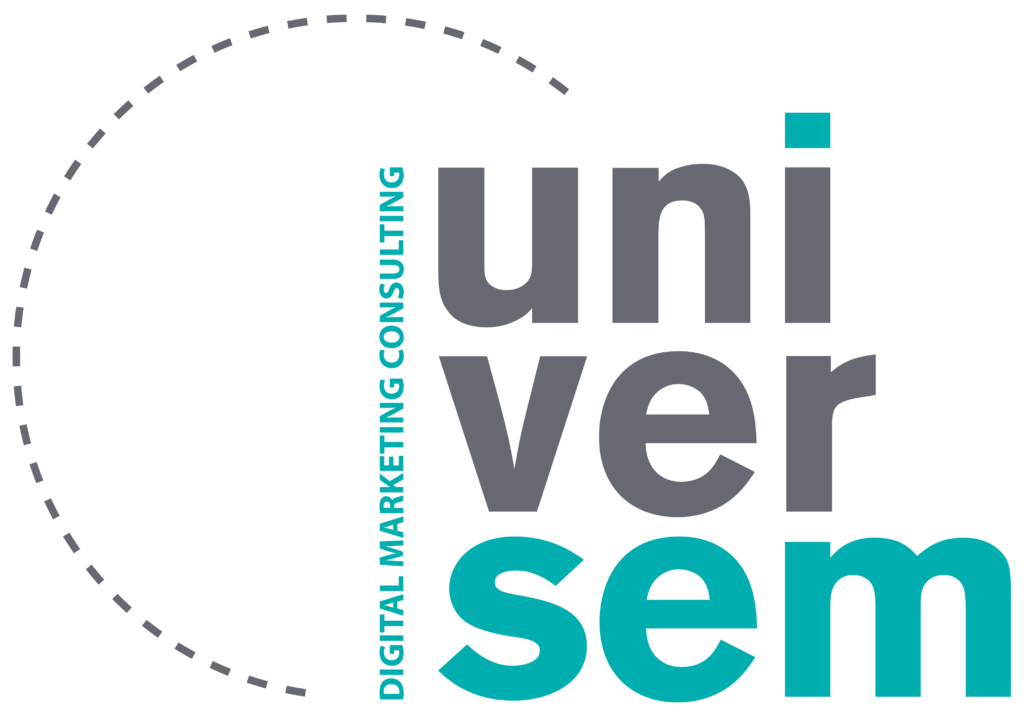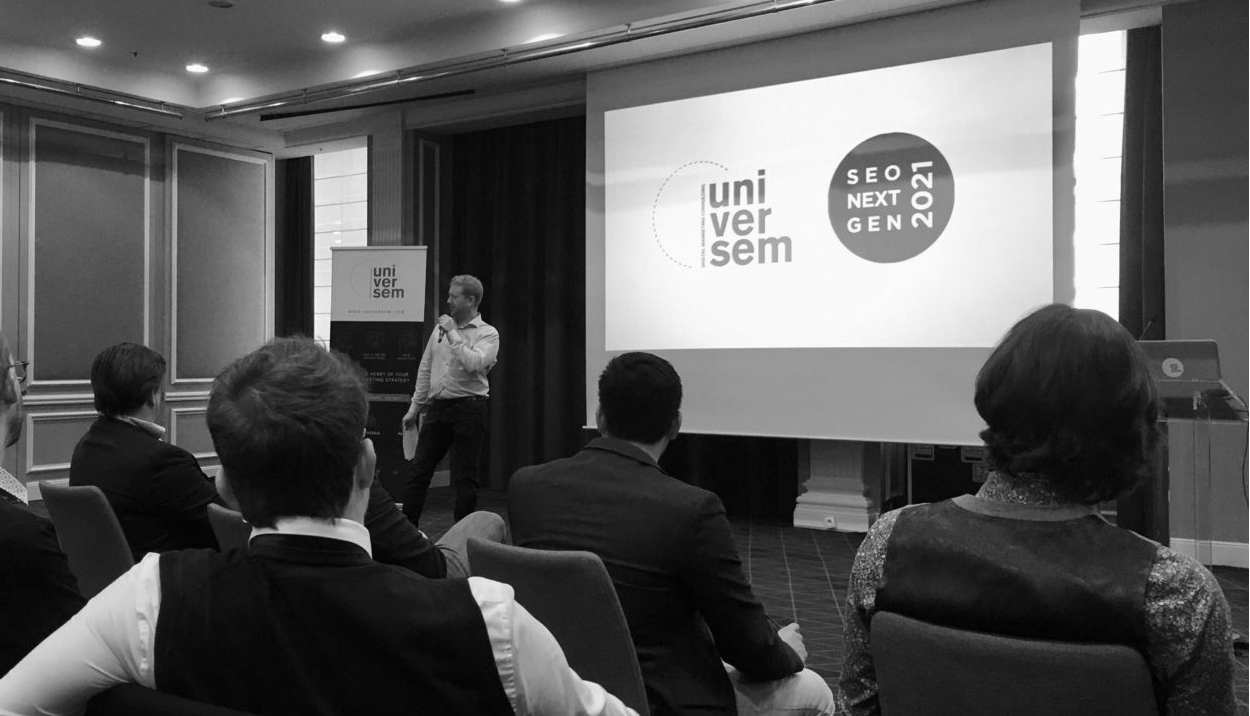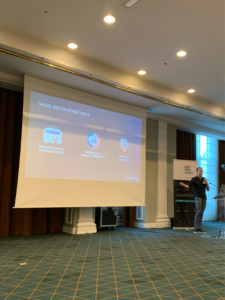What a pleasure it is to participate face-to-face to events again! To see the participants in person and not through screens. On Thursday, October 28 2021, the third edition of our event dedicated to SEO, the “SEO Next Gen”, took place. It was an opportunity for us to deliver some SEO best practices, but also and above all, to share a friendly moment.
What’s new in the SEO world? What should we expect in the future? What do we need to do to obtain good SEO results? These are all questions that we discussed in a presentation divided into three parts. We share the main points with you in this article.
Did you not have the opportunity to attend the presentation? Contact our marketing department at marketing@universem.com to get access to the recording!
Check out our after-movie and make your mouth water before diving into the rest of the article :
Part 1: what is the best SEO recipe for 2021?

Hubert de Cartier, one of the founders of Universem, opened the ball by reminding us of the basic principles of SEO, and gave us a glimpse of what will happen tomorrow in this constantly evolving world.
The first thing to remember is to create the right content for the right audience. This means that you have to start your SEO strategy by clearly defining which audience you are targeting and what information they are looking for (what are the right keywords?).
Our SEO recept, step by step
1) Prepare your ingredients for a technically clean website: Google’s biggest concerns is making user’s life easier and making their actions on the web more secure. To do this, search engine takes many factors into account to decide how it will rank your site in its results pages. For this, several factors are to consider:
- The loading speed of your site
- The use of HTML language
- Core Web Vitals (content loading speed, responsiveness, visual stability)
- and many others
Also note that today, 60% of Google searches are done on mobile phones. It is therefore important to take this into account when designing your website. The site must be pleasant to consult, even on a small screen.
2) Mix your ingredients to get unique and tasty content for your audience: have you ever heard of the MUM algorithm? It’s the future of Google. This new algorithm will allow search engines to respond even more accurately to user’s requests.
Thanks to this technology, Google will be able to interpret even better the context of every piece of information it finds on the web. It’s an artificial intelligence that is 1.000 times more efficient than current systems, allowing to understand both written data and images. It is therefore even important to work on the content of your site. Developing a maximum of internal links and key themes through content has never been as important as it is today.
3) Make your content appealing, so that people will talk about it: having good content is one thing, but don’t neglect the way you deliver the information. You need to show Google and your users that you’re a reliable source in your field of activity. How do you do this? Here are some tips:
- Try to get links from other websites that are known and trusted players in your field
- Ask satisfied customers to leave comments on your Google My Business profile
- Write high value-added content and bring something more than your competitors
In short, the secret of the recipe focusses on the user experience and on rich content that proves your credibility and your trustworthiness.
Part 2: why is SEO essential to your marketing strategy and how do you measure its value?
A question discussed by Jean-Francis Gothuey, our Head of SEO. He began by explaining one thing: SEO needs to be worked on as an independent medium, but also in synergy with other media.
SEO as a stand-alone medium
Why is SEO, as such, important? Simply because as soon as you are present on the Internet, people will find information about you. Whether you have worked on your SEO or not. So, you might as well make sure that this information is the right one and in your best interest.
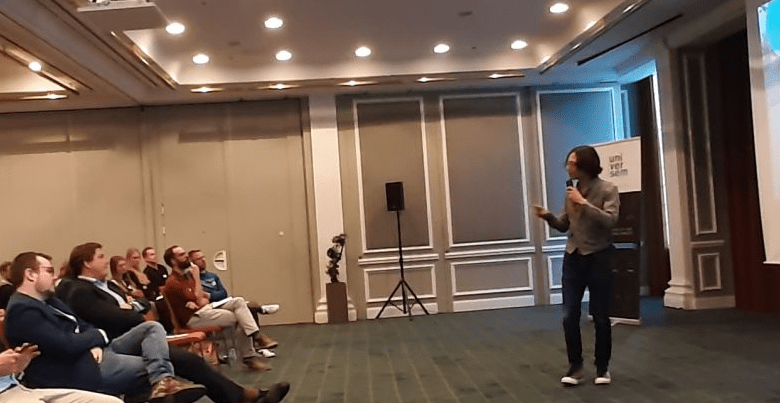
But how do you get there? Here are some ideas shared by Jean-Francis:
Make sure you correctly answer users’ questions. Create landing pages on your site that target the most common requests related to your brand and area of expertise.
What are the benefits of SEO as a stand-alone medium?
- An SEO strategy can easily be put on pause if necessary: SEO results are visible in the long term and require technical, as well as editorial optimisations. You can continuously work on your SEO and it’s not because you are slowing things down for a short time that all efforts will be lost.
- Adaptable to available resources and budget: a big advantage of SEO is that it offers many possibilities of how to work on your site. Indeed, depending on your resources, it will always be possible to call on external help to write content or implement technical recommendations.
- Possibility of breaking down the actions: can’t you implement all the SEO recommendations at once? No problem. In SEO, not everything has to be implemented at the same time. You can decide to work on one aspect before another, according to your schedule.
SEO in synergy with SEA
Did you know that your Ads campaigns can be reinforced by your SEO strategy? Imagine typing in Google a query such as “Red women’s shoes”. It’s clear that you don’t want to come across a web page that offers you purple pyjamas for men. And that’s what Google thinks too. The search engine has therefore developed a scoring system that evaluates the quality of the landing pages of your Ads.
The higher your score, the lower your cost per click (CPC). A well-structured site will allow you to have quality pages on a maximum of subjects. All you must do is to point your Ads to the most appropriate pages. And why not specially create pages to reinforce your SEA campaigns?
How to measure the return on investment of your SEO strategy?
Measuring what you get from an SEO strategy may seem more complex than for a SEA strategy. Indeed, there is no data available giving you the CPC of your campaigns. However, there is a simple calculation that can give you an idea:
Take the number of clicks you get in a given period, multiply it by the CPC of your Ads campaign and you get the value of your SEO.
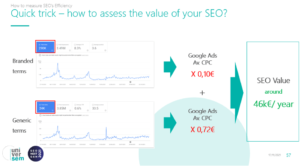
Part 3: the succes story of Belrobotics
There’s nothing better than a case study to get an idea of the impact of a work that has been done. Corentin Donneaux, one of our SEO consultants, and Diederick Geerinckx, Sales & Marketing Director of Yamabiko Europe (of which Belrobotics is a part), were pleased to share with us the lessons learned from their collaboration.
A challenging and long-standing collaboration, as it started in 2016. Belrobotics’ goal was to be recognised as a leading brand on the field of professional lawn mowers. Belrobotics offers robotic mowers for mowing large areas such as football pitches, parks, and golf courses.
How was the collaboration challenging?
- It was about attracting the right traffic: many people search the web for general information about lawn mowers (“price of a lawn mower”, “lawn mower reviews”…). Not everyone is looking for professional products. Belrobotics products have a certain cost and are dedicated to specific uses, so it was important to target the right keywords and the people who type these keywords.
- Extensive multilingual project: the objective was to target a large market comprising 16 countries and 22 different languages. A complex task, given that search habits and terms can be completely different from one culture to another.
- Competition with the big brands: other actors of the sector were already present with websites with a lot of content and products, both BtoB and BtoC.
How did we achieve the goals of Belrobotics?
Given the specifics of the project, Corentin has in particular:
- worked a lot on the content of the site, notably by writing many blog articles
- offered continuous monitoring of the implementation of SEO recommendations
- create several semantic analyses (notably for Belgium, Germany and Austria)
- worked in synergy with our Advertising team
We would also like to thank Belrobotics, which was very involved in the collaboration and provided us with complete and relevant information on its products. This allowed us to write content with high added value.
The result of the collaboration was a nice increase of the traffic on the Belrobitics website. Indeed, it has been multiplied by 2.5 between January 1st 2021 and October 19th 2021! A great collaboration that will continue in 2022 with the objective to optimize the SEO in Northern Europe.
Part 4: what impact will the disappearance of cookies have on SEO and how to prepare for it?
This is a question that is on everyone’s lips right now. How are we going to get actionable data if cookies go away? We had the pleasure of discussing this question with Sem, Digital Transformation Manager at Traffic Builders. Thanks again Sem for your intervention!
In Belgium, more than 30% of users refuse cookies
Even if users accept cookies, other blocking factors may follow. Among them are advertising blockers, but also browsers that block the transmission of data to the analysis platforms. Take for example Safari, which has decided that the lifetime of its analytics cookies will be… 24 hours! And it would not be surprising if other browsers follow. The result of all this? Incomplete and inaccurate data.
How does this impact your SEO?
Cookies are files that are deposited by your browser and are used to store information about your browsing. They make it possible to know whether you have arrived on a site for the first time or whether you are returning to it. Because cookies reveal user-specific information, it is important that they are protected. Laws such as the GDPR have therefore been put in place for this purpose.
You may have noticed that despite all this, you still have data in your analytics tools. You can still see the number of new visitors to your site, the conversion rate, etc. Yes, but… this data could be inaccurate.
An example: if I go to a website with Safari and I return to it two days later, I will be counted twice as a new user by the browser. If I go to the website with the Chrome browser (whose cookie lifetime is 30 days), and I return two days later, Chrome will remember me. It will then tell your analytics platform that it has observed two sessions for the same user.
What can you put in place?
As you can see, you can’t blindly rely on the data from your analytics platform. However, Sem explained to us that there are a few solutions to overcome this problem.
First thing, rely on other data:
- analyse the ranking in the Google Search Console
- redefine your KPI’s: try to calculate the average worth of a session on your website to enhance SEO
- Revisit your conversion strategy: focus on conversions that usually occur during the first visit to a website (free downloads for example)
The second is to opt for technical solutions such as ITP-tooling and server-level tagging:
ITP-tooling allows you to extend the life of cookies and cross-reference data from multiple sources, giving you more reliable information. Server-level tagging consists of interposing a cloud server between your website and your analytics platform. This prevents web browsers from blocking certain data. Indeed, they can block data sent to the Google Analytics platform, but not to your own server. Be careful though: you will have to be vigilant about data collection in order to respect the current legislation.
Please note that Traffic Builders has developed a lot of documentation about deleting cookies. If you would like to know more about it, please contact us.
Would you like to acces the presentation recording or want to improve your SEO?
Ask our marketing department via marketing@universem.com to get the video or contact our SEO team if you want to improve your website visibility with Universem!
